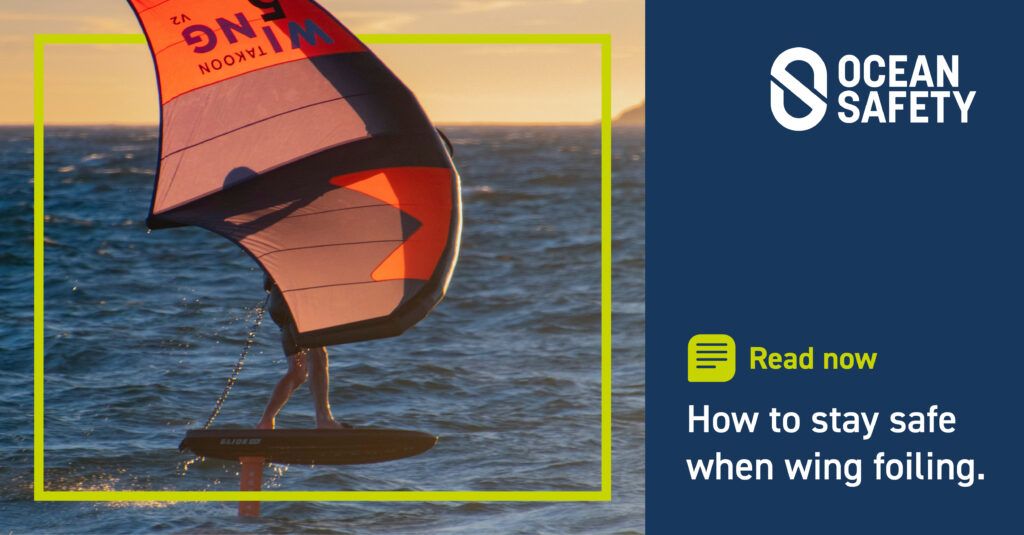Exhilarating and serious fun, the relatively new watersport of wing foiling is gaining in popularity; it needs less kit than kiting, less space to kit up and the foil makes it possible to have a great session even in very light winds.
As with all watersports, safety is key to ensuring a positive and enjoyable experience on the water, so we’ve compiled our top safety tips for wing foiling – whether you’re just starting out or you’re already hooked.
EQUIPMENT CHECK
Safety on the water starts with reliable equipment. Before hitting the water, give your kit a thorough once over for any signs of damage or wear and tear.
Your pre-flight checks should include checking your wing, foil, board, and leashes are all in good condition, and working as intended. You don’t want to have to return to the beach early due to broken kit, and you certainly don’t want a long and exhausting paddle back to the shore if your wing leash fails!
Don’t forget to inspect the foil bolts too, making sure they’re intact and not stripped or bent.
SAFETY KIT
The absolute minimum of safety kit would be a Personal Flotation Device (PFD) or buoyancy aid – no matter how confident a swimmer you are. It will keep you afloat if you lose your board and/or wing, giving you the chance to recover before heading to shore or signalling for help. When choosing a PFD, make sure it fits correctly, isn’t restrictive and allows you to move freely.
You also need to think about protecting you – physically. Hitting the water at high speed can be like hitting concrete (and getting hit by your gear isn’t much fun either) so wearing a helmet and an impact vest is strongly recommended for everyone. After all, falls are not a matter of level or ability – an experienced rider executing a snazzy manoeuvre is just as likely to fall as a beginner rider just starting out.
Again, remember your leashes to stay connected to your gear! Both your board and your wing!
WEATHER AND CONDITIONS
Rough water and an offshore wind are not the best conditions for a ride – especially if you’re just getting started. Be mindful of the conditions, both weather and water, as they can change quickly.
An offshore wind can blow you away from the coast making it challenging and extremely tiring to get back upwind to the shore, especially if you’re a beginner. It’s best to begin with calm waters and light winds when you’re learning, before gradually progressing to stronger winds as you become more experienced.
EXPOSURE PROTECTION
Aided by a neoprene wetsuit, wing foiling is an all-year round activity for the hardy. A good fitting, suitably thick wetsuit will not only keep you comfortable during a session and allow you to stay out for longer – it’s also an essential bit of safety kit. If something went wrong (wind drops, fatigue, broken gear) your wetsuit will also help keep you warm until assistance arrives.
In the summer, you’re still likely to wear a wetsuit (albeit a thinner/shorter one) to prolong your time out on the water, but you’ll also need to think about sunscreen to protect yourself from the sun’s powerful rays.
Wing foiling is a physically demanding sport, so don’t forget to keep hydrated too.
GETTING OUT ON THE WATER
Always choose an easy access/egress point avoiding big shore breaks as these can be dangerous for both you and your equipment.
Stay away from any rocks, cliffs, or piers, and don’t forget to check the depth of the launching spot – the best areas to ride in are those where you can come straight back to the beach easily.
Avoid riding in really windy or wavy conditions (especially if the wind is offshore) unless you have a safety boat on hand.
LOCAL REGULATIONS AND BYELAWS
Wherever you’re riding, don’t forget to check the local regulations and byelaws as there’re often designated areas along the coast for sailing and wing foiling. If you’re not sure, avoid any crowds, seek a wide, open space and respect the priority on the water: When two riders come from opposite directions, the rider on starboard tack has priority over the rider on port tack, and before any jumps or changes in direction, make sure there’s enough room and you’re not going to cross anyone’s path.
ON-GOING TRAINING
Wing foiling is constantly evolving. Stay safe and make the most of your time out on the water by keeping up to date with the latest techniques, kit, and safety recommendations by attending workshops, reading articles, and watching online tutorials.
Wing foiling looks like it’s here to stay, so be safe, have fun and enjoy!

